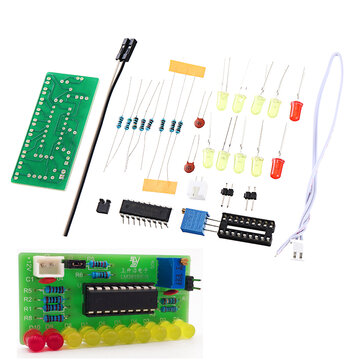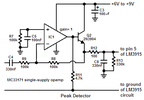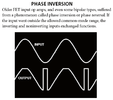Super-Dave
Member
I am TRYING to build a LED VU Meter to serve as a basis for a spectrum analyzer. Before I move onto the bandpass filters, I need to conquer the actual display. It is based on this design I found on the web.

It's 12v DC powered. R1 is 100k, R2-10 is 470k, D1-10 is 1N4148, LEDs are 3mm 2v or 3v (depending on the colors). Q1 is a 2N3904 NPN transistor.
It works, sort of. I have it hooked up to an unused pair of speaker outputs of a car stereo (4 channel, 2 for speakers, 2 for the display). My issue is: It isn't sensitive enough. It'll only start showing if the music is cranked to 25 (maxes out at 63, distortion ensues, 50 is best). Normal listening volume is 15-20.
This is my 3rd attempt now. 1st was without a transistor, essentially a LED diode/resistor ladder. It worked but only barely at max volume. 2nd attempt was with LM3914/3915's. Never made it past the breadboard stage, all sorts of goofy results. Back to the diode ladder.
I have tried to use an AC voltage doubler on the speaker outputs (with the transistorized meter) little success, then triple, then quadruple. I used 1N4148s instead of 1N4001s because that is what I had available.

They did manage to boost the LEDS to higher values but again ONLY at high volumes, never able to increase the low end sensitivity below 25. Add in a simple low pass filter and I need it cranked to 30 or more to get just 1 light to flicker. This won't work in my car. I would need obscene volumes just to see it, enough to piss off the neighbors and draw unwanted attention from the cops.
Is there a way to amplify the incoming signal to get it to light up at low volumes?
Thank you in advance for your responses.
It's 12v DC powered. R1 is 100k, R2-10 is 470k, D1-10 is 1N4148, LEDs are 3mm 2v or 3v (depending on the colors). Q1 is a 2N3904 NPN transistor.
It works, sort of. I have it hooked up to an unused pair of speaker outputs of a car stereo (4 channel, 2 for speakers, 2 for the display). My issue is: It isn't sensitive enough. It'll only start showing if the music is cranked to 25 (maxes out at 63, distortion ensues, 50 is best). Normal listening volume is 15-20.
This is my 3rd attempt now. 1st was without a transistor, essentially a LED diode/resistor ladder. It worked but only barely at max volume. 2nd attempt was with LM3914/3915's. Never made it past the breadboard stage, all sorts of goofy results. Back to the diode ladder.
I have tried to use an AC voltage doubler on the speaker outputs (with the transistorized meter) little success, then triple, then quadruple. I used 1N4148s instead of 1N4001s because that is what I had available.
They did manage to boost the LEDS to higher values but again ONLY at high volumes, never able to increase the low end sensitivity below 25. Add in a simple low pass filter and I need it cranked to 30 or more to get just 1 light to flicker. This won't work in my car. I would need obscene volumes just to see it, enough to piss off the neighbors and draw unwanted attention from the cops.
Is there a way to amplify the incoming signal to get it to light up at low volumes?
Thank you in advance for your responses.




